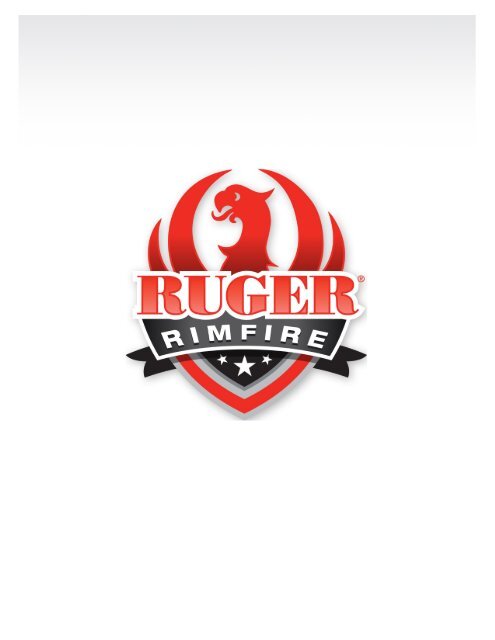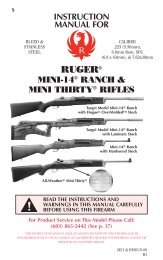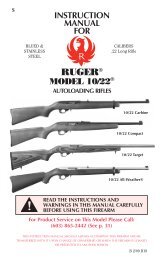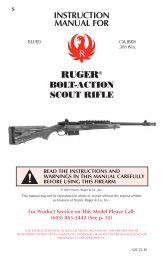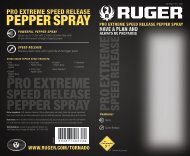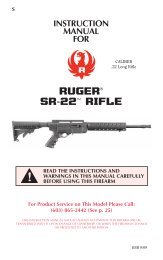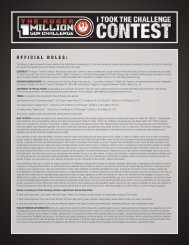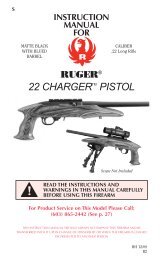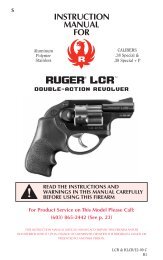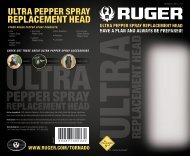Guidelines for Ruger Rimfire Competition
Guidelines for Ruger Rimfire Competition
Guidelines for Ruger Rimfire Competition
You also want an ePaper? Increase the reach of your titles
YUMPU automatically turns print PDFs into web optimized ePapers that Google loves.
<strong>Guidelines</strong> <strong>for</strong> <strong>Ruger</strong> <strong>Rimfire</strong> <strong>Competition</strong><br />
The <strong>Ruger</strong> <strong>Rimfire</strong> Challenge introduces participants to the fun and excitement of<br />
competitive shooting in a safe, low-pressure, family-friendly <strong>for</strong>mat. All levels of<br />
target shooters - new, novice and experienced - are welcome to compete. Each<br />
will find a challenge appropriate to his or her level of marksmanship.<br />
The <strong>Ruger</strong> <strong>Rimfire</strong> Challenge was developed with safety in mind. Shooters are<br />
required to compete using a rifle and handgun from any manufacturer<br />
chambered in the .22 Long Rifle caliber. The targets are steel plates that are set<br />
in a course of fire that is no less than 5 plates and no more than 7 plates. The<br />
course of fire is designed to be completed by even the most inexperienced<br />
shooter using one 10-round magazine without the need to reload “on the clock.”<br />
Steel plates were chosen as the targets because they are easy to buy or build,<br />
and because this type of target provides the shooter with immediate visual and<br />
audio feedback.<br />
A unique feature of the <strong>Ruger</strong> <strong>Rimfire</strong> Challenge is that experienced participants<br />
are encouraged to help new and novice shooters move up to the next level of<br />
proficiency by sharing their tips and shooting knowledge. Matches emphasize the<br />
friendly, supportive aspects of target shooting and competition. This low-key<br />
competition should remind participants that the shooting sports are lifetime<br />
activities that are fun and af<strong>for</strong>dable <strong>for</strong> men, women and youth.<br />
The initial investment required to participate in the <strong>Ruger</strong> <strong>Rimfire</strong> Challenge is<br />
low compared to other shooting sports. Since .22-caliber ammunition is very<br />
af<strong>for</strong>dable, a whole family can shoot without breaking the bank.<br />
All <strong>Ruger</strong> <strong>Rimfire</strong> Challenge competitions must include stages <strong>for</strong> both handgun<br />
and rifle chambered <strong>for</strong> .22 Long Rifle only. <strong>Competition</strong> is open to all safe and<br />
responsible individuals who can legally own or handle a firearm in the jurisdiction<br />
of the competition.<br />
Please read the <strong>Ruger</strong> <strong>Rimfire</strong> Challenge Rules below in order to get the most<br />
enjoyment out of participating in these matches. It’s important to understand the<br />
terminology used to describe participation in a match. The glossary of terms that<br />
is provided at the end of this document will help.<br />
As always, remember to safely handle firearms at all times and to store firearms<br />
safely when you are finished shooting.<br />
We hope you enjoy the <strong>Ruger</strong> <strong>Rimfire</strong> Challenge target shooting experience, and<br />
we encourage you to bring your friends and family members to matches as<br />
spectators or, even better, as participants.
Table of Contents<br />
Chapter<br />
Page No.<br />
Chapter 1 – General Safety 5<br />
1.1 Eye and ear protection 5<br />
1.2 Firearms 5<br />
Chapter 2 – Tournament Divisions 6<br />
2.1 Open 6<br />
2.2 Limited 6<br />
2.3 Special Recognition Categories 6<br />
2.4 Competing in Multiple Classes 6<br />
2.5 Firearm Substitution 7<br />
2.6 Two Gun Requirement 7<br />
Chapter 3 – Targets and Scoring 7<br />
3.1 Targets 7<br />
3.2 Scoring 8<br />
3.3 Hits 8<br />
3.4 Option Plates 8<br />
3.5 Penalties 8<br />
Chapter 4 – Course Design 9<br />
4.1 Maximum Number of Shots 9<br />
4.2 Target Distance 9<br />
4.3 Target Size Recommendation 9<br />
4.4 Order of Engagement 9<br />
4.5 Safe Angles of Fire 9<br />
4.6 Target Location 9<br />
4.7 Shooting Box 9<br />
4.8 Posting COF 10<br />
4.9 In<strong>for</strong>mation Precedence 10<br />
4.10 Stage Description 10<br />
4.11 COF Safety 10
Chapter 5 – Handgun Ready Condition 10<br />
5.1 Revolvers 10<br />
5.2 Self Loading Pistols 11<br />
5.3 Magazines 11<br />
5.4 Handgun Definitions 11<br />
Chapter 6 – Rifle Ready Conditions 11<br />
6.1 Rifles 11<br />
6.2 Magazines 11<br />
Chapter 7 – Participant Ready Condition 12<br />
7.1 Starting Position 12<br />
7.2 Participant Readiness 12<br />
Chapter 8 – Range Communications 12<br />
8.1 Range Commands 12<br />
Chapter 9 - Loading, Reloading or Unloading During a Course of Fire 14<br />
9.1 Safety 14<br />
9.2 Clearing a Malfunction 14<br />
Chapter 10 – Assistance or Interference 14<br />
10.1 Range Safety Officer (RSO) Assistance 14<br />
10.2 Interference 15<br />
10.3 Safety Warnings 15<br />
10.4 Mobility Assistance 15<br />
10.5 Inadvertent Contact 15<br />
Chapter 11 – Sight Pictures and Range Inspection 15<br />
11.1 Sight Picture 15<br />
11.2 Prohibitions 15<br />
11.3 Alterations 15<br />
Chapter 12 – Match Disqualification 15<br />
12.1 Accidental Discharge 15<br />
12.2 Negligent Discharge 16<br />
12.3 Unsafe Gun Handling 16<br />
Chapter 13- Conduct 18<br />
13.1 Participant Conduct 18
13.2 Non Participant Conduct 18<br />
13.3 Substance Abuse 18<br />
13.4 Offensive Clothing 18<br />
Chapter 14- Disputes 18<br />
14.1 Settlement of Disputes 18<br />
14.2 Reshoots 18<br />
14.3 Arbitration 19<br />
Chapter 15 – Safety Areas 19<br />
15.1 Use of Safety Areas 19<br />
15.2 Ammunition in Safety Areas 20<br />
Chapter 16 – Match Results 20<br />
16.1 Match Scores 20<br />
16.2 Preliminary Results 20<br />
16.3 Protest Period 20<br />
16.4 Challenge of Preliminary Results 20<br />
16.5 Breaking a Tie 20<br />
Chapter 17 – Prize Distribution 20<br />
17.1 Eligibility 20<br />
17.2 Prize Distribution (Non World Championship) 20<br />
17.3 Prize Distribution (World Championship) 20<br />
17.4 Multiple Entries 20<br />
Appendix A – Sample Stage Description 21<br />
Appendix B – Glossary of Terms 22
1.0 General Safety<br />
Always follow the basic rules of firearm safety:<br />
1.0.1 Treat all firearms as if they are loaded.<br />
1.0.2 Learn the mechanical and handling characteristics of the firearm<br />
you are using.<br />
1.0.3 Always keep the muzzle pointed in a safe direction; never point a<br />
firearm at anything that you are not intending to shoot.<br />
1.0.4 Keep your finger off the trigger until you are ready to shoot.<br />
1.0.5 Firearms should be unloaded and securely stored when not in use.<br />
1.0.6 Be sure the barrel is clear of obstructions be<strong>for</strong>e using.<br />
1.0.7 Be sure of your target be<strong>for</strong>e you shoot.<br />
1.0.8 Never climb a tree or fence, or do anything awkward with a loaded<br />
firearm.<br />
1.0.9 Never transport a loaded firearm.<br />
1.0.10 Avoid alcoholic beverages or drugs when shooting or handling a<br />
gun.<br />
1.1 Eye and ear protection<br />
1.1.1 All participants, range workers and spectators are required to use<br />
eye and ear protection.<br />
1.2 Firearms<br />
1.2.1 No suppressed or fully automatic firearms are allowed.<br />
1.2.2 Participants are responsible <strong>for</strong> ensuring that any and all equipment<br />
they bring to the match is fully in compliance with all laws in the jurisdiction<br />
where the match is being held. Participants are solely and personally<br />
responsible <strong>for</strong> the safety of any and all equipment and ammunition they<br />
bring to the match.<br />
1.2.3 Firearms by any manufacturer that meet the division or special<br />
class recognition criteria are acceptable in <strong>Ruger</strong> <strong>Rimfire</strong> Challenge<br />
events.<br />
1.2.4 All firearms are to safely use .22 Long Rifle ammunition. Any<br />
commercially available .22 LR ammunition will be considered suitable <strong>for</strong><br />
competition.<br />
1.2.5 All ranges hosting <strong>Ruger</strong> <strong>Rimfire</strong> Challenge matches are “Cold<br />
Ranges.” All firearms will be kept unloaded except in the designated<br />
shooter area under the direct supervision of a Match Official.<br />
1.2.6 During the match, participants will refrain from handling their<br />
firearms, except when instructed by a Match Official or in Safety Areas.
1.2.7 All firearms must be in hard or soft cases or gun rugs when brought<br />
to the designated shooting area and must be in hard or soft cases or gun<br />
rugs when removed from the designated shooting area. No holsters are<br />
allowed.<br />
2.0 Tournament Divisions<br />
2.1 Open<br />
2.1.1 Any firearm (pistol or revolver in handgun class) with scopes,<br />
optical sights, light gathering scopes, battery powered optics, lasers,<br />
compensator or muzzle brake.<br />
2.2 Limited<br />
2.2.1 Guns with iron sights. Adjustable sights, fiber optics are allowed but<br />
no electronic sights. No compensators, muzzle brakes or barrel weights.<br />
2.3 Special Recognition Categories<br />
2.3.1 Cowboy/Cowgirl<br />
2.3.1.1 Single-action revolvers and period lever-action or pumpaction<br />
rifles with iron sights. All participants in Cowboy/Cowgirl<br />
class must wear a cowboy hat in competition.<br />
2.3.2 Manually Operated<br />
2.3.2.1 Rifle must be manually operated, bolt action, lever action,<br />
slide or pump action and iron sights. Handgun would be doubleaction<br />
revolver with iron sights.<br />
2.3.3 Top Lady<br />
2.3.3.1 Female participants of any age may compete in this<br />
category.<br />
2.3.4 Top Youth<br />
2.3.4.1 Both male and female participants age 12 and under may<br />
compete in this category.<br />
2.3.5 Top Junior<br />
2.3.5.1 Both male and female participants age 13-18 may<br />
compete in this category.<br />
2.3.6 Top Senior<br />
2.3.6.1 Both male and female participants age 62 and older may<br />
compete in this category.<br />
2.3.7 There must be at least three (3) participants in a given category <strong>for</strong><br />
that category to be recognized in a match.
2.4 Participants may compete in more than one division if event organizers<br />
allow, and only if it can be accomplished in a safe and timely manner.<br />
2.4.1 The participant must declare his/her primary division at registration<br />
(e.g., Open or Limited).<br />
2.4.2 The participant will shoot his/her primary division first. The<br />
participant may complete the match with his/her primary division firearms<br />
and then complete the match with the second division firearms. Or the<br />
participant may complete a portion of the match with the primary division<br />
firearms and the same portion with his/her secondary division firearms;<br />
this may be the method in the case of a two-day match. The participant<br />
would then complete the match on the second day starting with his/her<br />
primary division firearms and finishing with his/her secondary division<br />
firearms.<br />
2.4.3 The participant may only be in possession of the score sheets <strong>for</strong><br />
the division in which he/she is currently competing.<br />
2.5 The same firearm specified in a Category and Division must be used<br />
throughout a specific match.<br />
2.5.1 If there is a mechanical problem requiring a change of equipment,<br />
equipment of similar make or model may be used as a replacement,<br />
subject to the approval of the Match Director. The replacement equipment<br />
must meet the same Category and Division guidelines and restrictions as<br />
the original equipment.<br />
2.5.2 No change in firearm is permitted without the approval of the Match<br />
Director. If a participant makes such a change without prior approval, they<br />
will be disqualified from the match.<br />
2.5.3 If the equipment guidelines cannot be met with the replacement<br />
firearm the contestant may be eligible <strong>for</strong> recognition in another Category<br />
or Division, but will remain eligible <strong>for</strong> Overall Awards.<br />
2.6 Participants must compete with a handgun and a rifle in order to qualify <strong>for</strong><br />
prizes; the exception to this would be youth participants who are prohibited from<br />
shooting handguns based on age restrictions in the residing area.<br />
3.0 Targets and Scoring<br />
3.1 Targets<br />
3.1.1 All targets will be static steel plates.<br />
3.1.2 Minimum recommended target size is 8 inches and may be any<br />
shape (e.g. cowboy steel). If the available targets are smaller they may be<br />
used but remember, bigger easy to hit targets up close is the winning<br />
<strong>for</strong>mula, (90% of the people should be able to hit 90% of the targets 90%<br />
of the time).
3.1.3 Dented, cupped or pocked metal targets may not be used.<br />
3.1.4 Targets used <strong>for</strong> <strong>Ruger</strong> <strong>Rimfire</strong> Challenge events should be easy to<br />
purchase or build.<br />
3.1.5 All targets are to be painted white and will be repainted prior to<br />
each participant’s first attempt on each course of fire.<br />
3.2 Scoring<br />
3.2.1 In <strong>Rimfire</strong> Challenge the time is the score.<br />
3.2.2 Each stage consists of five (5) to seven (7) targets, hereafter<br />
referred to as plates, that are shot five (5) times, each of the five times is<br />
referred to as a String of Fire or String. One (1) plate will be designated<br />
the Stop Plate. Each of the standard targets must be hit at least once<br />
be<strong>for</strong>e hitting the stop plate, and the time stops when the stop plate is hit.<br />
Participants may fire as many rounds as they deem necessary or until the<br />
firearm is empty <strong>for</strong> each string of fire. The worst string on each stage will<br />
be thrown out, and the total of the four (4) remaining times will be<br />
participant’s score <strong>for</strong> that stage.<br />
3.3 A steel plate will be considered hit if the bullet has left a clear mark on the<br />
edge or face of the plate. If there is no discernable mark it will be scored as a<br />
miss.<br />
3.3.1 If a Range Safety Officer (RSO) scores a miss, it is the shooter’s<br />
responsibility to appeal the decision at the end of that particular string. The<br />
RSO will go downrange to inspect the target.<br />
3.3.2 If the participant still believes the call is in error, he/she may appeal<br />
to the Match Director (MD). The MD’s decision will be final, and no further<br />
appeals will be allowed with respect to that scoring decision.<br />
3.3.3 Once the next string of fire has begun, there will be no further<br />
opportunity to appeal the RSO’s decision.<br />
3.4 Score is total time plus penalties. If a course of fire contains targets that<br />
will reduce the overall score (option plates), they should be computed after all<br />
other scoring is completed <strong>for</strong> each string.<br />
3.5 Penalties<br />
3.5.1 Each missed target will incur a 2-second penalty.<br />
3.5.2 Failure to finish the course of fire during a string or not hitting the<br />
Stop Plate results in a 30-second penalty time (total time) <strong>for</strong> that string.<br />
3.5.3 The maximum score <strong>for</strong> any string is 30 seconds, no matter how<br />
many misses or penalties may have been accrued during the string.<br />
3.5.4 Calculate all misses per string, not per stage. In a match where the<br />
shooter is allowed to drop the highest time <strong>for</strong> each stage, any miss<br />
penalties applying to the string/score being dropped will also be dropped.<br />
3.5.5 Foot fault, shooter engaging targets while his/her foot is in contact
with the ground outside the designated shooting area will incur a 2-second<br />
penalty per shot fired while in fault condition.<br />
3.5.6 A false start will incur a 2-second penalty.<br />
3.5.7 It is the shooter’s responsibility to provide the correct score sheet <strong>for</strong><br />
each course of fire and entry division, and to verify his/her scores as<br />
written on the score sheet when finished shooting each course of fire.<br />
3.5.7.1 Any questions regarding the scores entered on the score sheet<br />
should be directed to the RSO on the course of fire be<strong>for</strong>e signing the<br />
score sheet. If questions remain, the Match Director should be<br />
summoned.<br />
3.5.7.2 When the score sheet has been signed by the participant and the<br />
RSO, it is definitive and cannot be changed other than to correct math<br />
errors or by mutual consent of the MD and participant.<br />
4.0 Course design<br />
4.1 All courses of fire will be set so that only one 10-round magazine is<br />
necessary to complete the course of fire. Magazine reloads are not allowed. A<br />
participant may use high-capacity magazines in jurisdictions where they are<br />
allowed, but if more than 11 rounds are fired on a string then the participant will<br />
be scored 30 seconds <strong>for</strong> that string.<br />
4.2 The minimum distance <strong>for</strong> a course of fire is 7 yards or 21 feet and the<br />
maximum distance <strong>for</strong> courses of fire is 20 yards or 60 feet <strong>for</strong> pistol and 35<br />
yards or 105 feet <strong>for</strong> rifle.<br />
4.3 If targets are to be placed at or near maximum distances, the targets<br />
should be larger and easy to hit.<br />
4.4 A course of fire may specify where or when the shooter engages specific<br />
targets.<br />
4.5 Each course-of-fire design or layout must have safe angles of fire.<br />
4.5.1 Course designers must take into consideration the safe target and<br />
frame construction and the angle of any possible ricochet.<br />
4.5.2 Courses of fire must be designed to ensure that targets are set at<br />
heights where a missed target by the smallest shooter will not travel over<br />
the backstops or berms.<br />
4.6 When a course design includes target locations other than immediately<br />
downrange,<br />
4.6.1 Organizers must protect or restrict surrounding areas to which<br />
participants, officials or spectators have access.<br />
4.6.2 In all courses of fire, target arrangements are set in ways so that<br />
shooting at them will not cause participants to breach safe angles of fire.
4.7 Shooters will engage courses of fire from a single shooter’s box. No<br />
moving, running or walking should be required of the shooter during the course of<br />
fire.<br />
4.8 Posting the Course of Fire at each stage is mandatory <strong>for</strong> all <strong>Ruger</strong><br />
<strong>Rimfire</strong> Challenge matches. A match program book is not required; however, it is<br />
encouraged if feasible.<br />
4.9 In<strong>for</strong>mation posted at the stage takes precedence over all other stage<br />
descriptions unless otherwise noted by the MD or RSO.<br />
4.10 A Stage Description must provide the following minimum in<strong>for</strong>mation: (see<br />
sample in Appendix A)<br />
4.10.1 Scoring Method.<br />
4.10.2 Targets (type & number).<br />
4.10.3 Minimum number of rounds.<br />
4.10.4 Number of strings to be shot.<br />
4.10.5 The firearms ready condition.<br />
4.10.6 Start position.<br />
4.10.7 Time starts: audible or visual signal.<br />
4.10.8 Procedure.<br />
4.11 Matches must be designed, constructed and conducted with due<br />
consideration to safety.<br />
4.11.1 Courses of fire should not be “mind games” or designed to trick<br />
participants into making mistakes or being unsafe.<br />
4.11.2 <strong>Ruger</strong> <strong>Rimfire</strong> Challenge staff reserves the right to modify courses<br />
of fire deemed unsafe or not reflecting the purpose of <strong>Ruger</strong> <strong>Rimfire</strong><br />
Challenge competition.<br />
5.0 Handgun Ready Conditions<br />
The ready condition <strong>for</strong> handguns will normally be as stated below. However, in<br />
the event that a participant fails to load the chamber when permitted by the<br />
written stage briefing, whether inadvertently or intentionally, the RSO should<br />
communicate this to the participant so they may correct the condition prior to<br />
starting the course of fire.<br />
5.1 Revolvers:<br />
5.1.1 Single Action: Cowboy/Cowgirl class participants must have two (2)<br />
single- action revolvers loaded with six (6) rounds in each per string, or<br />
one (1) higher- capacity single-action revolver loaded with up to 10<br />
rounds.<br />
5.1.1.1 If the participant is using two 6-shot revolvers, both
evolvers may start with the hammer resting on a loaded chamber.<br />
5.1.1.2 The participant's second revolver shall be placed on a<br />
table in front of him or her.<br />
5.1.1.3 If the participant is using one higher-capacity single-action<br />
revolver loaded with up to 10 rounds, the hammer may rest on a<br />
loaded chamber.<br />
5.1.2 Double-action: hammer fully down and all chambers may be<br />
loaded.<br />
5.2 Self-loading Pistols:<br />
5.2.1 “Single action” – chamber loaded, hammer cocked.<br />
5.2.2 “Double action” – chamber loaded, hammer fully down or<br />
decocked.<br />
5.2.3 “Selective action” – chamber loaded with hammer fully down, or<br />
chamber loaded and hammer cocked.<br />
5.3 All magazines will be loaded with 10 rounds maximum. Participants using<br />
self-loading pistols may start with a round in the chamber. This allows the<br />
participant to start with a maximum of 11 rounds in the firearm. A participant may<br />
use high-capacity magazines in jurisdictions where they are allowed, but if more<br />
than 11 rounds are fired on a string then the participant will be scored 30<br />
seconds <strong>for</strong> that string.<br />
5.3.1 Open and Limited Pistol and Rifle shooters are encouraged to have<br />
at least five (5) magazines <strong>for</strong> each gun to keep the stage from getting<br />
bogged down on loading magazines.<br />
5.4 In respect of handguns used at <strong>Ruger</strong> <strong>Rimfire</strong> Challenge matches, the<br />
following definitions apply:<br />
5.4.1 “Single Action” means activation of the trigger causes a single<br />
action to occur (i.e., the hammer or striker falls).<br />
5.4.2 “Double Action” means activation of the trigger causes more than a<br />
single action to occur (i.e., the hammer or striker rises or retracts, then<br />
falls).<br />
5.4.3 “Selective Action” means that the handgun can be operated in<br />
either “Single Action” or “Double Action” modes.<br />
6.0 Rifle Ready Conditions<br />
The ready condition <strong>for</strong> rifles will normally be as stated below. However, in the<br />
event that a participant fails to load the chamber when permitted by the written<br />
stage briefing, whether inadvertently or intentionally, the RSO should<br />
communicate this to the participant so they may correct the condition prior to<br />
starting the course of fire.
6.1 Rifles:<br />
6.1.1 Loaded: magazine filled and fitted (if applicable), chamber loaded,<br />
hammer and/or sear cocked.<br />
6.2 All magazines will be loaded with 10 rounds maximum. Participants using<br />
self-loading rifles may start with a round in the chamber. This allows the<br />
participant to start with a maximum of 11 rounds in the firearm. A participant may<br />
use high- capacity magazines in jurisdictions where they are allowed, but if more<br />
than 11 rounds are fired on a string then the participant will be scored 30<br />
seconds <strong>for</strong> that string.<br />
6.2.1 Open and Limited Pistol and Rifle shooters are encouraged to have<br />
at least five (5) magazines <strong>for</strong> each gun to keep the stage from getting<br />
bogged down on loading magazines.<br />
6.1.3 Tubular magazines may be loaded to maximum, but if more than 11<br />
rounds are fired on a string then the participant will be scored 30 seconds<br />
<strong>for</strong> that string.<br />
7.0 Participant Ready Condition<br />
This designates when, under the direct command of a RSO,<br />
7.0.1 The firearm is prepared as specified in the written stage briefing,<br />
and is in compliance with the requirements of the relevant Division.<br />
7.1 Starting Position<br />
7.1.1 Handgun Participant will start with handgun in hand(s) ready to fire<br />
with the safety disengaged, aiming at a designated object (orange cone)<br />
10 feet down range. Alternate start position may be elbows at side with<br />
arms and gun barrel parallel with ground.<br />
7.1.2 Rifle Participant will start with rifle in hand(s) ready to fire with the<br />
safety disengaged, aiming at a designated object (orange cone) 10 feet<br />
down range. Alternate start position may be with stock of rifle touching hip<br />
with rifle barrel parallel with ground.<br />
7.2 Each participant is expected to come to the firing line ready to shoot, with<br />
an appropriate amount of ammunition in an appropriate number of magazines or<br />
speed-loaders or other loading devices.<br />
7.2.1 Match delays caused by (<strong>for</strong> example) excessive time spent loading<br />
magazines while on the firing line may be referred to the MD <strong>for</strong> guidance.<br />
7.2.2 A participant may have an assistant to help them in reloading, if<br />
needed.<br />
7.2.3 If the participant is not prepared and it would cause a severe delay<br />
while they prepare, the RSO may move them down in the shooting order<br />
until they are prepared.
8.0 Range Communication<br />
The approved range commands and their sequence are as follows:<br />
8.1 Range Commands<br />
8.1.1 “Shooter Load and Make Ready” – This command signifies the start<br />
of the course of fire. Under the direct supervision of the RSO, the<br />
participant must face down range, or in a safe direction as specified by the<br />
RSO, fit eye and ear protection, and prepare the firearm in accordance<br />
with the written stage briefing. The participant must then assume the<br />
required start position. At this point, the RSO will proceed.<br />
8.1.1.1 Once the “Shooter Load and Make Ready” command<br />
has been given, the participant must not move away from the start<br />
location prior to issuance of the “Start Signal” without the prior<br />
approval, and under the direct supervision, of the RSO.<br />
8.1.2 “Shooter Ready?” – The lack of any negative response from the<br />
participant indicates that he fully understands the requirements of the<br />
course of fire and is ready to proceed. If the participant is not ready at the<br />
“Shooter Ready?” command, he/she must state “Not Ready.” It is<br />
suggested that when the participant is ready, he/she should assume the<br />
required start position to indicate his readiness to the RSO.<br />
8.1.3 “Standby” – This command should be followed by the start signal<br />
within 2 to 3 seconds.<br />
8.1.4 “Start Signal” – The signal <strong>for</strong> the participant to begin their attempt<br />
at the course of fire. If a participant fails to react to a start signal, <strong>for</strong> any<br />
reason, the RSO will confirm that the participant is ready to attempt the<br />
course of fire, and will resume the range commands from “Shooter<br />
Ready"?<br />
8.1.4.1 In the event that a participant begins his attempt at<br />
the course of fire prematurely (“false start” prior to the issuance of<br />
the start signal), the participant will incur a penalty. If the participant<br />
is able to return to the designated start position prior to the start<br />
signal, no penalty will be assessed.<br />
8.1.5 “Stop” – Any RSO assigned to a stage may issue this command at<br />
any time during the course of fire. The participant must immediately cease<br />
firing, stop moving and wait <strong>for</strong> further instructions from the RSO.<br />
8.1.6 RSOs may issue other interim commands on completion of the first<br />
string in order to prepare the participant <strong>for</strong> the second and subsequent<br />
strings (e.g., “Reload <strong>for</strong> the Next String”).<br />
8.1.7 “If You Are Finished, Unload And Show Clear” – If the participant<br />
has finished shooting, he/she must lower the firearm and present it <strong>for</strong><br />
inspection by the RSO with the muzzle pointed down range, magazine
emoved, slide locked or held open, and chamber empty. Revolvers must<br />
be presented with the cylinder swung out and empty.<br />
8.1.8 “If Clear, Hammer Down, and Bag Firearm” – After issuance of this<br />
command, the participant is prohibited from firing. While continuing to<br />
point the firearm safely downrange, the participant must per<strong>for</strong>m a final<br />
safety check of the firearm as follows:<br />
8.1.8.1 Self-loaders – release the slide or bolt and pull the<br />
trigger (without touching the hammer or decocker, if any). Slide or<br />
bolt may be left at slide lock.<br />
8.1.8.2 Revolvers – close the empty cylinder (without<br />
touching the hammer, if any).<br />
8.1.8.3 If the gun proves to be clear, the participant must bag<br />
the firearm prior to leaving the designated shooting area and while<br />
still under the direct supervision of the RSO.<br />
8.1.8.4 If the gun does not prove to be clear, the RSO will<br />
resume the commands from Section 6.7.<br />
8.1.9 “Range Is Clear” – This declaration signifies the end of the course<br />
of fire. Once the declaration is made, officials and participants may move<br />
<strong>for</strong>ward to score, paint, reset targets, etc.<br />
8.1.10 Failure to comply with RSO commands will result in a warning. Two<br />
warnings of any kind on a single stage will result in a match<br />
disqualification.<br />
8.1.11 Should a participant’s equipment malfunction, the string of fire will<br />
be scored, the range will be cleared per Section 6.8, and the participant<br />
will be allowed to repair or replace the equipment. The RSO will proceed<br />
with the next participant.<br />
8.1.11.1 The RSO will retain the participant’s score sheet until the<br />
participant returns to resume his/her attempts at the stage.<br />
8.1.11.2 In the event that a firearm cannot be unloaded due to a<br />
broken or failed mechanism, the shooter will notify the RSO. Under<br />
no circumstances will a participant leave the firing line with a loaded<br />
firearm (See Section 12.3.13).<br />
9.0 Loading, Reloading or Unloading During a Course of Fire<br />
9.1 When loading, reloading or unloading during a course of fire, the<br />
participant’s fingers must be visibly outside the trigger guard and the firearm<br />
must be pointed safely down range or in another safe direction authorized by a<br />
RSO (see Section 12.3).<br />
9.2 The participant MUST keep his/her finger outside of the trigger guard<br />
while clearing a malfunction.
10.0 Assistance or Interference<br />
10.1 RSOs are encouraged to assist the Participant. RSOs may tell a<br />
participant a gun is not loaded or the safety is on. RSO’s may assist a shooter at<br />
the shooter’s request. (Remember, we are here to ensure a positive experience<br />
<strong>for</strong> new shooters). When approved by the RSO, participants may, without penalty,<br />
receive whatever coaching or assistance they request.<br />
10.2 Any person providing interference or unauthorized assistance to a<br />
participant during a course of fire (and the participant receiving such assistance)<br />
may, at the discretion of a RSO, incur a procedural penalty <strong>for</strong> that stage.<br />
10.3 The RSO assigned to a stage may issue safety warnings to a participant<br />
at any time. Such warnings will not be grounds <strong>for</strong> the participant to be awarded<br />
a reshoot.<br />
10.4 Participants confined to wheelchairs or similar devices may be given<br />
special dispensation by the MD in respect of mobility assistance.<br />
10.5 In the event that inadvertent contact from the RSO or another external<br />
influence has interfered with the participant during a course of fire, the RSO may<br />
offer the participant a reshoot of the course of fire.<br />
10.5.1 The participant must accept or decline the offer prior to seeing<br />
either the time or the score from the initial attempt.<br />
10.5.2 In the event that the participant commits a safety infraction during<br />
any such interference, the provisions of Section 12.0 may still apply.<br />
11.0 Sight Pictures and Range Inspection<br />
11.1 A participant is permitted to take a sight picture prior to the start signal.<br />
Such sight picture is only permitted from the “Shooter Load and Make Ready”<br />
location.<br />
11.2 Participants are prohibited from using any guns or gun replicas as sighting<br />
aids while conducting their inspection (“walkthrough”) of a course of fire.<br />
11.3 No person is permitted to enter or move through a course of fire<br />
without the prior approval of a RSO assigned to that course of fire or<br />
the MD. Altering targets or any other part of a course will be subject to<br />
the provisions of Section 13.0.
12.0 Match Disqualification<br />
12.1 Accidental Discharge<br />
A participant who causes an accidental discharge must be stopped by a RSO as<br />
soon as possible. An accidental discharge occurs after the start signal has been<br />
sounded and is defined as follows:<br />
12.1.1 A shot, which travels over a backstop, a berm or in any other<br />
direction, specified in the written stage briefing by the match organizers as<br />
being unsafe. Note that a participant who legitimately fires a shot at a<br />
target, which then travels in an unsafe direction, will not be disqualified.<br />
12.1.2 A shot which strikes the ground within 10 feet of the participant.<br />
12.1.2.1 Exception — A bullet which strikes the ground within 10<br />
feet of the participant due to a “squib.”<br />
12.1.2.2 In the case of a shot striking a prop where the bullet is<br />
deflected or does not continue to strike the ground, if the RSO<br />
determines that the bullet would have struck the ground within 10<br />
feet of the participant had it not been deflected or stopped by the<br />
prop, the provisions of 12.1.2 shall apply.<br />
12.1.3 A shot which occurs during remedial action in the case of a<br />
malfunction.<br />
12.2 Negligent Discharge<br />
A participant who causes a Negligent Discharge must be stopped by a RSO as<br />
soon as possible. A Negligent Discharge occurs be<strong>for</strong>e the start signal or after<br />
the completion of a course of fire and is defined as follows:<br />
12.2.1 A shot which occurs while loading, reloading or unloading a firearm.<br />
This includes any shot fired after the “Make Ready” command is given.<br />
12.2.1.1 Exception – a detonation, which occurs while unloading a<br />
firearm, is not considered a shot or discharge subject to a match<br />
disqualification; however, firearms must be serviceable and safe.<br />
RSOs may demand examination of a participant’s firearm or related<br />
equipment, at any time, to check that they are functioning safely. If<br />
any such item is declared unserviceable or unsafe by a RSO, it<br />
must be withdrawn from the match until the item is repaired to the<br />
satisfaction of the MD.<br />
12.3 Unsafe Gun Handling<br />
Examples of unsafe gun handling include, but are not limited to:<br />
12.3.1 Handling a firearm at any time except when in a designated safety<br />
area or when under the supervision of, and in response to a direct<br />
command issued by, a RSO.<br />
12.3.2 If at any time during the course of fire, a participant allows the<br />
muzzle of his handgun to point rearwards, that is further than 90 degrees
(breaking the 180) from straight ahead of the participant, or allows the<br />
muzzle to point up range, whether the handgun is loaded or not.<br />
12.3.3 If at any time during the course of fire, or while loading, reloading or<br />
unloading, a participant drops his handgun or causes it to fall, loaded or<br />
not. Note that a participant who, <strong>for</strong> any reason during a course of fire,<br />
safely and intentionally places the handgun on the ground or other stable<br />
object will not be disqualified provided:<br />
12.3.3.1 The participant maintains constant physical contact with<br />
the handgun, until it is placed firmly and securely on the ground or<br />
another stable object, and<br />
12.3.3.2 The participant remains within 3 feet of the handgun at all<br />
times (except where the handgun is placed at a greater distance,<br />
under the supervision of a RSO), and<br />
12.3.3.3 The provisions of Rule 12.2 do not occur, and<br />
12.3.3.4 The firearm is in the ready condition, or<br />
12.3.3.5 A self-loading firearm has an empty chamber, the<br />
magazine removed and the slide or bolt locked open, or<br />
12.3.3.6 A revolver has the cylinder open and empty.<br />
12.3.4 Allowing the muzzle of a handgun to point at any part of the<br />
participant’s body during a course of fire (i.e., sweeping).<br />
12.3.5 Using more than one handgun at any point in time during a course<br />
of fire with the following exception.<br />
12.3.5.1 When using a single-action revolver while competing in the<br />
Cowboy/Cowgirl Division.<br />
12.3.6 Failure to keep the finger outside the trigger guard while clearing a<br />
malfunction where the participant clearly moves the handgun away from<br />
aiming at targets.<br />
12.3.7 Failure to keep the finger outside the trigger guard during loading,<br />
reloading or unloading. Exception: while complying with the “Make Ready”<br />
command to lower the hammer of a gun without a decocking lever, or<br />
while initially loading a revolver with a spurless hammer.<br />
12.3.8 Handling live or dummy ammunition (including practice or training<br />
rounds, snap caps and empty cases), loaded magazines or loaded speed<br />
loading devices in a Safety Area. The word “handling” does not preclude<br />
participants from entering a Safety Area with ammunition in magazines or<br />
speed loading devices on their belt, in their pockets or in their range bag,<br />
provided the participant does not physically remove the loaded magazines<br />
or loaded speed loading devices from their retaining or storage device<br />
while within the Safety Area.
12.3.9 Having a loaded firearm other than when specifically ordered to by<br />
the RSO.<br />
12.3.10 Retrieving a dropped firearm. Dropped firearms must always be<br />
retrieved by a Range Officer who will, after checking and/or clearing the<br />
firearm, place it directly into the participant’s gun case or gun bag.<br />
Dropping an unloaded firearm or causing it to fall outside of a course of<br />
fire is not an infraction; however, a participant who retrieves a dropped<br />
firearm will receive a match disqualification.<br />
12.3.11 Using metal piercing, incendiary and/or tracer ammunition, and/or<br />
using any ammunition which has been deemed unsafe by a RSO.<br />
12.3.11.1 Ammunition declared unsafe by a RSO due to multiple<br />
squibs, shall not subject the participant to disqualification.<br />
13.0 Conduct<br />
This is a family-oriented event. Youngsters tend to repeat what they see.<br />
Lead by example.<br />
13.1 Participants will be disqualified from a match <strong>for</strong> conduct that a Match<br />
Official deems to be unsportsmanlike. Examples of unsportsmanlike conduct<br />
include, but are not limited to cheating, dishonesty, failing to comply with the<br />
reasonable directions of a Match Official, or any behavior likely to negatively<br />
impact the image of the sport. The MD must be notified of any such conduct as<br />
soon as possible.<br />
13.2 Other persons (non-participant) may be expelled from the range <strong>for</strong><br />
conduct that a Match Official deems to be unacceptable. Examples of<br />
unacceptable conduct include, but are not limited to, failing to comply with the<br />
reasonable directions of a Match Official, interference with the operation of a<br />
course of fire and/or a participant's attempt thereof, and any other behavior<br />
impacting the safe management of the match.<br />
13.3 All persons are required to be in complete control both mentally and<br />
physically during matches. Safe per<strong>for</strong>mance by participants and officials at<br />
matches must not be affected by drugs (or alcohol) of any sort during matches.<br />
Any person who, in the opinion of the MD, is visibly under the influence of any<br />
substance and not able to function safely will be disqualified from the match and<br />
may be required to leave the range.<br />
13.4 Offensive or objectionable garments are not allowed on the range.<br />
Anyone wearing items deemed to be offensive or objectionable will be<br />
asked to change or leave the range facility. The MD will have final<br />
authority regarding garments deemed offensive or objectionable.
14.0 Disputes<br />
14.1 All disputes are to be settled by the RSO on the range where the issue<br />
has become evident be<strong>for</strong>e the squad moves on. If necessary, the MD may be<br />
consulted. The decision is immediate and final.<br />
14.2 Reshoots<br />
14.2.1 Any participant that experiences a target malfunction or a range<br />
problem during a course of fire is entitled to reshoot the course once the<br />
problem is resolved (this is not a firearm/ammo malfunction).<br />
14.2.2 A firearm/ammo-related malfunction will not result in a reshoot<br />
(mulligan). Reshoots or mulligans <strong>for</strong> equipment malfunction are NOT<br />
allowed at any <strong>Ruger</strong> <strong>Rimfire</strong> Challenge matches.<br />
14.2.3 Not reshooting a course of fire when the Range Officer directs you<br />
to will result in a no score <strong>for</strong> that string if multiple strings are shot on that<br />
stage. If the stage has only one string, then a result of no score <strong>for</strong> the<br />
stage will result.<br />
14.3 Any participant has a Right of Arbitration (protest).<br />
14.3.1 A participant who wishes an official review of a competitive matter<br />
may file a protest.<br />
14.3.2 The protest must be prepared in writing and submitted to the MD<br />
within one hour of the close of competition on the day of the occurrence.<br />
14.3.3 A protest must be accompanied by a $100 cash fee. If the protest is<br />
decided in favor of the participant, the fee will be returned to the<br />
participant, if the protest is denied (the original competitive decision is<br />
upheld), the fee will be <strong>for</strong>feit to the match.<br />
14.3.4 The participant is responsible <strong>for</strong> the preparation and delivery of the<br />
written appeal, together with the appropriate fee. Both must be submitted<br />
to the MD within the specified period of time.<br />
14.3.5 The RSO’s ruling on whether an observed action occurred shall be<br />
considered factual (e.g., foot faults, accidental discharges, breaking the<br />
180, hit/miss on a target).<br />
14.3.6 Upon receipt of a valid protest, the MD will convene an Arbitration<br />
Board, consisting of three experienced participants that are not material to<br />
the protest.<br />
14.3.7 The Arbitration Board must reach a decision within 24 hours of the<br />
request <strong>for</strong> arbitration or be<strong>for</strong>e the match results have been declared final<br />
by the MD.<br />
14.3.8 The decision of the Arbitration Board is final and may not be<br />
appealed.
15.0 Safety Areas<br />
The host organization is responsible <strong>for</strong> the construction and placement of a<br />
sufficient number of Safety Areas <strong>for</strong> the match. They should be conveniently<br />
placed and easily identified with signs. Safety Areas should include a table with<br />
the safe direction and boundaries clearly shown.<br />
15.1 Participants are permitted to use the Safety Areas <strong>for</strong> the activities stated<br />
below provided they remain within the boundaries of the Safety Area and the<br />
firearm is pointed in a safe direction. Violations are subject to match<br />
disqualification (see Rule 12.3).<br />
15.1.1 Casing and uncasing unloaded firearms.<br />
15.1.2 Practice “dry-firing” of unloaded firearms.<br />
15.1.3 Practice the insertion and removal of empty magazines and/or to<br />
cycle the action of a firearm.<br />
15.1.4 Conduct inspections, stripping, cleaning, repairs and maintenance<br />
of firearms, component parts and other accessories.<br />
15.2 Dummy ammunition (including practice or training rounds, snap caps and<br />
empty cases), loaded magazines, loaded speed loading devices and live rounds<br />
must not be handled in a Safety Area under any circumstances.<br />
16.0 Match results<br />
16.1 Match scores (times) will be calculated to two (2) decimal places.<br />
16.2 Preliminary match results must be posted at the match stats area or other<br />
common area accessible to all participants as soon as possible.<br />
16.3 A protest period of no less than 30 minutes will be allowed <strong>for</strong> participants<br />
to challenge the preliminary match results. This protest may be verbal.<br />
16.4 Participants who fail to challenge preliminary match results with the MD<br />
within 30 minutes of their posting and prior to when the match results have been<br />
declared final by the MD will not have any further recourse.<br />
16.5 A tie score in a match will be decided by the winning score that the tied<br />
participants shot on the first stage (Stage 1) of the match. If the tie persists, the<br />
winner will be decided by the winning score of the tied participants shot on the<br />
second stage (Stage 2) of the match and so on until the tie is broken.<br />
17.0 Prize distribution<br />
17.1 Participants must compete with both a handgun and a rifle in order to<br />
qualify <strong>for</strong> prizes. The exception to this would be youth participants who are<br />
prohibited from shooting handguns based on age restrictions in the residing area.
17.2 All firearms donated by Industry are to be given by lottery only (except<br />
World Championship match).<br />
17.3 Prize distribution <strong>for</strong> the World Championship Match shall be "order of<br />
finish" in both Limited and Open with a prize table <strong>for</strong> each division or alternating<br />
selections between divisions.<br />
17.4 Any participant that completes the match in multiple divisions may walk<br />
the prize table <strong>for</strong> each division completed as long as the participant paid the full<br />
entry price <strong>for</strong> each division entered.
Appendix A
Appendix B<br />
Glossary of Terms<br />
180 Rule: A participant allows the muzzle of his handgun to point rearwards, that<br />
is further than 90 degrees (breaking the 180) from straight ahead of the<br />
participant, or allows the muzzle to point up range, whether the handgun is<br />
loaded or not.<br />
.22 Long Rifle: Self-contained rimfire cartridge .22 inches in diameter<br />
Barrel: The metal tube of a firearm made from iron or steel, through which the<br />
bullet or shot charge passes when the firearm is fired.<br />
Barrel Weight: Weights which are clamped to the barrel and are designed to give<br />
the shooter more muzzle control.<br />
Category: Used to identify a specific group of participants.<br />
Chamber: The enlarged portion of the barrel at the breech in which the cartridge<br />
is placed ready <strong>for</strong> firing.<br />
Course of Fire (also “course” and “COF”): An expression used interchangeably<br />
with “Stage.”<br />
Compensator: Device that is either fitted to, or designed as a permanent part of,<br />
the muzzle of a firearm to redirect propellant gases with the effect of countering<br />
both recoil of the gun and unwanted rising of the barrel during rapid fire.<br />
Division: Used to identify the type of firearms that will be used by a participant in<br />
competition.<br />
False Start: Beginning an attempt at a COF prior to the “Start signal.”<br />
Foot Fault: Firing a shot while the participant’s foot touches the ground outside<br />
the shooting box.<br />
Full Auto Firearm: A firearm which continuously fires ammunition when the<br />
trigger is pulled only once.<br />
Hammer: The part of the action that drives the firing pin <strong>for</strong>ward.<br />
Match Director (MD): An individual or group of individuals appointed by a club<br />
and given the task of running the match.
Match Official: A person who has an official duty or function at a match, but who<br />
is not necessarily qualified as, or acting in the capacity of, a Range Officer.<br />
Plate: Targets used in <strong>Ruger</strong> <strong>Rimfire</strong> Challenge competition. Plates are made of<br />
steel, typically A500 3 / 8 to ½ inch thick.<br />
Magazine: The part of a repeating firearm which holds the cartridges or shells in<br />
position ready to be loaded one at a time into the chamber. (The magazine may<br />
be an integral part of a firearm or a separate device attached to the action.).<br />
Minimum # of Rounds: Minimum number of shots required to complete the COF.<br />
Muzzle: The <strong>for</strong>ward end of a barrel.<br />
Muzzle Brake: See Compensator.<br />
Procedure: The manner in which a COF must be engaged.<br />
Range Safety Officer (RSO): The person who is in complete charge of the range<br />
facility and is responsible <strong>for</strong> range safety. Their duties include direct supervision<br />
of all activities on the firing line.<br />
Ready Condition: The state in which the shooter and firearm are ready to<br />
engage<br />
the COF.<br />
Reshoot: A participant’s further attempt at a course of fire, authorized in advance<br />
by a Range Officer or an Arbitration Committee.<br />
<strong>Rimfire</strong>: A cartridge in which the priming compound is contained in the rim at the<br />
base of the cartridge.<br />
Safety Area: An area designated <strong>for</strong> the safe handling of unloaded firearms.<br />
Scoring: Total time plus penalties.<br />
Sear: The part of a firearm which links the trigger and the firing pin and releases<br />
it when the trigger is pulled.<br />
Shooting Box: A small shooting area (generally square) <strong>for</strong>med of four<br />
connected fault lines.<br />
Squib: A malfunctioned cartridge that lacks sufficient power to fire its bullet from<br />
the muzzle resulting in the bullet being lodged in the bore.
Stage: An arrangement of targets that the participant must shoot <strong>for</strong> score.<br />
Stage Briefing: A full description of the stage and all in<strong>for</strong>mation regarding how it<br />
is to be shot.<br />
Start position: The location, shooting position and stance prescribed by a COF<br />
prior to issuance of the “Start signal.”<br />
Static Steel Plate. A steel plate that does not fall or move when hit.<br />
String: The shots fired when a participant engages a COF once.<br />
String of Fire: See String.<br />
Stop Plate: The plate designated to be shot last in the COF.<br />
Suppressed Firearm: A firearm with a device attached to or part of the barrel to<br />
reduce the amount of noise and flash generated by firing.<br />
Sweeping: Allowing the muzzle of a firearm to point at any part of the shooter’s<br />
body.<br />
Trigger: The part of a firearm mechanism which releases the firing pin.<br />
Trigger Guard: A metal loop around the trigger designed to protect it.First and<br />
<strong>for</strong>emost, <strong>Ruger</strong> <strong>Rimfire</strong> events are to be safe and fun. They are designed to promote the<br />
fun of shooting <strong>for</strong> all members of the family in a safe, wholesome environment.


